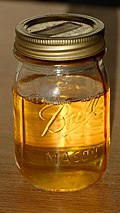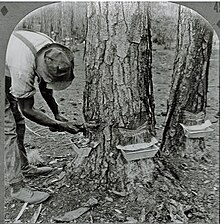Turpentine
 Turpentine distilled at theGeorgia Museum of Agriculture & Historic Villageas it was done circa 1900
| |
| Identifiers | |
|---|---|
| ECHA InfoCard | 100.029.407 |
| EC Number |
|
PubChemCID
|
|
| UNII | |
CompTox Dashboard(EPA)
|
|
| Properties[1] | |
| C10H16 | |
| Molar mass | 136.238g·mol−1 |
| Appearance | Viscous liquid |
| Odor | Resinous |
| Melting point | −55 °C (−67 °F; 218 K) |
| Boiling point | 154 °C (309 °F; 427 K) |
| 20 mg/L | |
| Hazards | |
| NFPA 704(fire diamond) | |
| Flash point | 35 °C (95 °F; 308 K) |
| 220[1]°C (428 °F; 493 K) | |
Except where otherwise noted, data are given for materials in theirstandard state(at 25 °C [77 °F], 100 kPa).
| |
Turpentine(which is also calledspirit of turpentine,oil of turpentine,terebenthine,terebenthene,terebinthineand, colloquially,turps)[2]is a fluid obtained by thedistillationofresinharvested from living trees, mainlypines.Principally used as a specializedsolvent,it is also a source of material fororganic syntheses.
Turpentine is composed ofterpenes,primarily the monoterpenesAlpha -andbeta-pinene,with lesser amounts ofcarene,camphene,limonene,andterpinolene.[3]
Substitutes includewhite spiritor otherpetroleumdistillates – although the constituent chemicals are very different.[4]
Etymology
[edit]The wordturpentinederives (viaFrenchandLatin) from theGreekword τερεβινθίνηterebinthine,in turn the feminine form (to conform to thefeminine genderof the Greek word, which means "resin" ) of an adjective (τερεβίνθινος) derived from the Greek noun (τερέβινθος) for theterebinthtree.[5]
Although the word originally referred to the resinous exudate of terebinth trees (e.g.Chios turpentine,Cyprus turpentine,andPersian turpentine),[6][7]it now refers to that ofconiferoustrees, namelycrude turpentine(e.g. Venice turpentine is theoleoresinoflarch),[8]or thevolatile oilpart thereof, namely oil (spirit) of turpentine; the later usage is much more common today.[9]
Source trees
[edit]



Important pines for turpentine production include: maritime pine (Pinus pinaster), Aleppo pine (Pinus halepensis), Masson's pine (Pinus massoniana), Sumatran pine (Pinus merkusii),longleaf pine(Pinus palustris), loblolly pine (Pinus taeda), slash pine (Pinus elliottii), and ponderosa pine (Pinus ponderosa).
To tap into the sap producing layers of the tree, harvesters used a series of hacks to remove the pine bark. Once debarked, pine trees secrete crude turpentine (oleoresin) onto the surface of the wound as a protective measure to seal the opening, resist exposure to micro-organisms and insects, and prevent vital sap loss. Harvesters wounded trees in V-shaped streaks down the length of the trunks to channel the crude turpentine into containers. It was then collected and processed into spirits of turpentine. Crude turpentine yield may be increased by as much as 40% by applyingparaquatherbicidesto the exposed wood.[10]
The V-shaped cuts are called "catfaces" for their resemblance to a cat's whiskers. These marks on a pine tree indicate it was used to collect resin for turpentine production.[11]
Turpentine (and rosin) are produced asnaval stores.[12]Pine trees especially inNorth Carolinawere tapped for sap which was doubly distilled to make turpentine androsin(aka resin)–hence the nametar heel.The trees were scored with a ledge called a "box" to collect the sap. Large numbers ofslaveswere used to score the trees, collect and process the sap. Historian Jeremy B. Zallen describes this as industrial slavery, which was different from the more common instance of slaves in agriculture. By the 1840scamphine(also spelled camphene) became one of the dominant lamp fuels in the US.[12]
The pine trees of North Carolina were well suited to camphine production. The business also provided additional need for slaves as production expanded. Backwoods became more productive. Slaves were often leased in winter when agriculture was slower. The value of many was protected bylife insurance.Wilmingtonbecame a center of the camphine industry. In cities,gas lightingwas also available, but used by the upper classes. Camphine was the fuel of the average family.
Zallen reports that afterFt. Sumter,turpentine producers were cut off from major markets.Emancipationleft them without manpower to collect and process turpentine. The camps were flammable. Many were burned inWilliam Tecumseh Sherman'smarchfromSavannahtoGoldsboro.
Converting crude turpentine to oil of turpentine
[edit]Crude turpentinecollected from the trees may be evaporated bysteam distillationin acopperstill. Moltenrosinremains in the still bottoms after turpentine has been distilled out.[10]Such turpentine is calledgum turpentine.[13]The termgum turpentinemay also refer to crude turpentine, which may cause some confusion.
Turpentine may alternatively be extracted fromdestructive distillationof pine wood,[3]such as shredded pine stumps, roots, and slash, using the light end of the heavynaphthafraction (boiling between 90 and 115 °C or 195 and 240 °F) from a crudeoil refinery.Such turpentine is calledwood turpentine.Multi-stage counter-currentextractionis commonly used so fresh naphtha first contacts wood leached in previous stages and naphtha laden with turpentine from previous stages contacts fresh wood beforevacuum distillationto recover naphtha from the turpentine. Leached wood is steamed for additional naphtha recovery prior to burning forenergy recovery.[14]
Sulfate turpentine
[edit]When producing chemicalwood pulpfrompinesor otherconiferous trees,sulfate turpentine may be condensed from the gas generated inKraft processpulpdigesters.The average yield of crude sulfate turpentine is 5–10 kg/t pulp.[15]Unless burned at the mill for energy production, sulfate turpentine may require additional treatment measures to remove traces ofsulfurcompounds.[16]
Industrial and other end uses
[edit]Solvent
[edit]As a solvent, turpentine is used for thinning oil-basedpaints,for producingvarnishes,and as a raw material for the chemical industry. Its use as a solvent in industrialized nations has largely been replaced by the much cheaperturpentine substitutesobtained frompetroleumsuch aswhite spirit.A solution of turpentine andbeeswaxorcarnauba waxhas long been used as a furniture wax.
Lighting
[edit]Spirits of turpentine, calledcamphine,was burned in lamps with glass chimneys in the 1830s through the 1860s. Turpentine blended withgrain alcoholwas known as burning fluid. Both were used as domestic lamp fuels, gradually replacingwhale oil,untilkerosene,gas lightingandelectric lightsbegan to predominate.
Source of organic compounds
[edit]Turpentine is also used as a source of raw materials in the synthesis of fragrant chemical compounds. Commercially usedcamphor,linalool,Alpha -terpineol,andgeraniolare all usually produced fromAlpha -pineneandbeta-pinene,which are two of the chief chemical components of turpentine. These pinenes are separated and purified by distillation. The mixture ofditerpenesandtriterpenesthat is left as residue after turpentine distillation is sold asrosin.
Folk medicine
[edit]Turpentine and petroleum distillates such ascoal oiland kerosene, were used infolk medicinefor abrasions and wounds, as a treatment forlice,and when mixed withanimal fat,as a chest rub or inhaler for nasal and throat ailments.[17][18]Vickschest rubsstill contain turpentine in their formulations, although not as an active ingredient.[19]
Turpentine, now understood to be dangerous for consumption, was a common medicine among seamen during theAge of Discovery.It was one of several products carried aboardFerdinand Magellan's fleet during thefirst circumnavigation of the globe.[20]Taken internally it was used as a treatment forintestinal parasites.This is dangerous, due to the chemical's toxicity.[21][22]
Turpentineenemas,a very harsh purgative, had formerly been used for stubborn constipation or impaction.[23]They were also given punitively to political dissenters in post-independence Argentina.[24]
Niche uses
[edit]- Turpentine is also added to many cleaning and sanitary products due to itsantisepticproperties and its "clean scent".
- In early 19th-century America, spirits of turpentine (camphine) was burned in lamps as a cheap alternative towhale oil.It produced a bright light but had a strong odour.[25]Camphine andburning fluid(a mix of alcohol and turpentine) served as the dominant lamp fuels replacing whale oil until the advent ofkerosene,electric lightsandgas lighting.[26]
- Hondamotorcycles, first manufactured in 1946, ran on a blend of gasoline and turpentine, due to the scarcity of gasoline in Japan followingWorld War II.[27]
- In his bookIf Only They Could Talk,veterinarian and authorJames Herriotdescribes the use of the reaction of turpentine withresublimediodine to "drive the iodine into the tissue", or perhaps just impress the watching customer with a spectacular treatment (a dense cloud of purple smoke).[28]
- Turpentine was added extensively into gin during theGin Craze.[29]
Hazards
[edit]| NFPA 704 safety square | |
|---|---|
As anorganicsolvent, turpentine's vapour can irritate the skin and eyes, damage thelungsand respiratory system, as well as thecentral nervous systemwhen inhaled, and cause damage to therenal systemwhen ingested, among other things.[30]Ingestion can cause burning sensations, abdominal pain, nausea, vomiting, confusion, convulsions, diarrhea,tachycardia,unconsciousness, respiratory failure,[31]andchemical pneumonia.
TheOccupational Safety and Health Administration(OSHA) has set the legal limit (permissible exposure limit) for turpentine exposure in the workplace as 100 ppm (560 mg/m3) over an 8-hour workday. The same threshold was adopted by theNational Institute for Occupational Safety and Health(NIOSH) as therecommended exposure limit(REL). At levels of 800 ppm (4480 mg/m3), turpentine isimmediately dangerous to life and health.[32]
See also
[edit]- Galipot– Resin of turpentine obtained from pine trees
- McCranie's Turpentine Still– a historic site in Willacoochee, Georgia
- Naval stores industry– part of shipbuilding
- Patent medicine– over-the-counter "proprietary" medications
- Retsina– Greek wine flavored with Aleppo pine resin
- Russia leather– a water-resistant leather curried after tanning with a birch oil distillate similar to turpentine
References
[edit]- ^abRecord ofTurpentinein theGESTIS Substance Databaseof theInstitute for Occupational Safety and Health
- ^Mayer, Ralph (1991).The Artist's Handbook of Materials and Techniques(Fifth ed.). New York: Viking. p.404.ISBN0-670-83701-6.
- ^abKent, James A.Riegel's Handbook of Industrial Chemistry(Eighth Edition) Van Nostrand Reinhold Company (1983)ISBN0-442-20164-8p.569
- ^"Solvents".Ullmann's Encyclopedia of Industrial Chemistry.Weinheim: Wiley-VCH. 2002.doi:10.1002/14356007.a24_437.ISBN978-3527306732.
- ^Barnhart, R. K. (1995).The Barnhart Concise Dictionary of Etymology.New York: Harper Collins.ISBN0-06-270084-7.
- ^Skeat, Walter W. (1882).A Concise Etymological Dictionary of the English Language.Oxford, UK: Oxford University Press. p. 579.
- ^Mills, John S.; White, Raymond (1977)."Natural Resins of Art and Archaeology Their Sources, Chemistry, and Identification".Studies in Conservation.22(1): 12–31.doi:10.2307/1505670.ISSN0039-3630.JSTOR1505670.
- ^Mahood, S. A. (1921-03-01)."Larch (Venice) Turpentine from Western Larch (Larix occidentalis)".Journal of Forestry.19(3): 274–282.doi:10.1093/jof/19.3.274(inactive 2024-09-12).ISSN0022-1201.
{{cite journal}}:CS1 maint: DOI inactive as of September 2024 (link) - ^"Turpentine".Britannica.Retrieved2022-03-02.
- ^abKent p.571
- ^Prizer, Tom (June 11, 2010)."Catfaces: Totems of Georgia's Turpentiners | Daily Yonder | Keep It Rural".dailyyonder.Archived fromthe originalon July 26, 2015.RetrievedJune 5,2012.
- ^abZallen, Jeremy (2019).American Lucifers: The Dark History of Artificial Light, 1750-1865.Chapel Hill, NC: University of North Carolina Press.
- ^"Turpentine".Encyclopedia Britannica.Retrieved2022-05-16.
- ^Kent pp.571&572
- ^Stenius, Per, ed. (2000). "2".Forest Products Chemistry.Papermaking Science and Technology. Vol. 3. Finland: Fapet Oy: Published in cooperation with the Finnish Paper Engineers' Association andTAPPI.pp. 73–76.ISBN952-5216-03-9.
- ^Kent p.572
- ^"Surviving 'The Spanish Lady' (Spanish flu)".CBC News.2003-04-10. Event occurs at 03:20.Archivedfrom the original on 2020-08-07.Retrieved2018-12-29.
A turpentine and hot water, and [wring hot towels out of there], and put it on their chest and back. --Elsie Miller (nee Smith)
- ^Sarah Rieger (December 29, 2018)."100 years ago, a train carrying Spanish flu pulled into Calgary. Within weeks, Alberta was in crisis".CBC News.Archivedfrom the original on December 29, 2018.RetrievedDecember 29,2018.
- ^"DailyMed - VICKS VAPORUB (camphor- synthetic, eucalyptus oil, and menthol ointment".dailymed.nlm.nih.gov.Archivedfrom the original on 2021-05-05.Retrieved2021-05-05.
- ^Laurence Bergreen(2003).Over the edge of the world: Magellan's terrifying circumnavigation of the globe.HarperCollins.ISBN0066211735.Retrieved2009-09-14.
- ^"Home Remedies - American Memory Timeline- Classroom Presentation".American Memory Timeline.The Library of Congress.Archivedfrom the original on 2017-02-07.Retrieved2017-02-06.
- ^"ICSC 1063 - TURPENTINE".inchem.org.Archivedfrom the original on 2006-04-27.Retrieved2006-04-02.
- ^"Turpentine enema".Biology-Online Dictionary.Biology-Online. 7 October 2019.Archivedfrom the original on 2019-04-21.Retrieved2019-12-26.
- ^"Ribbons and Rituals". In "Problems in Modern Latin American History". Ed. Chasteen and Wood. Oxford, UK: Scholarly Resources, 2005. p. 97, ISBN 9781442218598 and 9781442218604
- ^Charles H. Haswell."Reminiscences of New York By an Octogenarian (1816 - 1860)".Archivedfrom the original on 2008-07-24.Retrieved2008-10-07.
- ^"The" Whale Oil Myth "".PBS NewsHour.20 August 2008.Archivedfrom the original on 10 May 2019.Retrieved25 March2018.
- ^"Honda History".Smokeriders.Archivedfrom the original on 2009-04-28.Retrieved2009-09-17.
- ^If Only They Could Talk.28 June 2012.Archivedfrom the original on 13 February 2021.Retrieved28 June2018– via amazon.co.uk.,summarised at"James Herriot Books".Retrieved28 June2018.[permanent dead link]
- ^Rohrer, Finlo (28 July 2014)."When gin was full of sulphuric acid and turpentine".BBC News.Archivedfrom the original on 19 July 2018.Retrieved2 January2018.
- ^"CDC - NIOSH Pocket Guide to Chemical Hazards - Turpentine - Symptoms".cdc.gov.Archivedfrom the original on 2015-12-08.Retrieved2015-11-27.
- ^"Turpentine".International Programme on Chemical Safety, World Health Organization.Archivedfrom the original on 2006-04-27.Retrieved2006-04-02.
- ^"CDC - NIOSH Pocket Guide to Chemical Hazards - Turpentine".cdc.gov.Archivedfrom the original on 2015-12-08.Retrieved2015-11-27.
External links
[edit]- Inchem.org,IPCSINCHEM Turpentine classification, hazard, and property table.
- CDC - NIOSH Pocket Guide to Chemical Hazards - Turpentine

